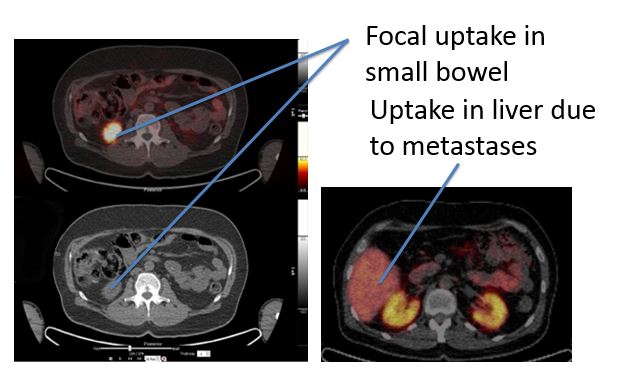A 42-year-old woman returned from her honeymoon in Egypt and complained to her GP that she kept getting facial flushes and diarrhoea. She assumed that it was due to infectious gastroenteritis from eating in Khan el-Khalili, the souk in Cairo, but it had persisted for 3 weeks.
After prescribing a course of antibiotics and checking a urine pregnancy test, her GP eventually referred her to a gastroenterologist.
-
1. What investigations would you request?
Show Answer
Correct answer:
The symptoms are suggestive of carcinoid and the diagnostic investigations are 24-hour urinary 5-hydroxyindole-acetic acid (5HIAA) and serum chromogranin A.
5HIAA is the excretory product of the metabolites produced by carcinoids and results from the breakdown of 5-hydroxytryptamine or serotonin (5HT). Twenty-four-hour urinary 5HIAA is a more specific test for carcinoid but requires careful collection of urine and exclusion of foods rich in tryptophan from diet (e.g. Aubergine, avocado, banana, tomato). Chromogranin A is a serum test and therefore easier but it is less specific than urinary 5HIAA.
The 24-hour urinary 5-HIAA was 33 mg (normal range: 2-8 mg/day).
The serum chromogranin A was 176 mg/L (normal range <93 mg/L).
-
2. What isotope scan is currently viewed as the most sensitive for localization of carcinoid tumours?
Show Answer
Correct answer:
DOTATATE (68Gallium-DOTA-Octreotate CT/PET imaging).
 Tumours may be localized by specialized isotope scanning with either an octreoscan or DOTATATE scan. Octreoscan uses a radiolabelled somatostatin analogue, 111Indium pentetreotide, and scintigraphy, whilst the newer and more sensitive DOTATATE scan uses 68Gallium-DOTA-Octreotate and CT/PET imaging.
Tumours may be localized by specialized isotope scanning with either an octreoscan or DOTATATE scan. Octreoscan uses a radiolabelled somatostatin analogue, 111Indium pentetreotide, and scintigraphy, whilst the newer and more sensitive DOTATATE scan uses 68Gallium-DOTA-Octreotate and CT/PET imaging.
-
3. The liver metastases account for her symptoms of carcinoid syndrome. How may these symptoms be relieved?
Show Answer
Correct answer:
The list of drugs used in the treatment of carcinoid symptoms include:
Inhibitors of 5HT synthesis such as parachlorphenylalanine
Peripheral 5HT antagonists such as cyproheptadine
Antihistamines
Inhibitors of 5HT release such as somatostatin and its long-acting analogues.
The most frequently used somatostatin analogue is octreotide and this leads to a relief of symptoms in 80% of patients for a median duration of 10 months.
She is treated with a combination of octreotide and the mTOR inhibitor everolimus. Her symptoms resolved. One year later there had been no change in the tumour size but she continued to be asymptomatic on this combination.


